Humanities Essay: Leonardo Da Vinci's Comparison of Arts Analysis
VerifiedAdded on 2023/06/10
|7
|1685
|405
Essay
AI Summary
This essay provides an analysis of Leonardo Da Vinci's 'Comparison of Arts,' focusing on his views on painting, sculpture, and poetry. Da Vinci favored painting, highlighting its universal appeal through visual imagery, contrasting it with poetry's dependence on language. He discussed the advantages and disadvantages of painting versus sculpture, emphasizing painting's ability to depict colors and light interactions. The essay explores the historical context of Da Vinci's notebooks, his artistic style, and the relevance of his work today, demonstrating how his ideas continue to influence art. The analysis deepens understanding of the principles of each art form and their impact on culture. Desklib provides access to this essay along with numerous other solved assignments and study resources for students.
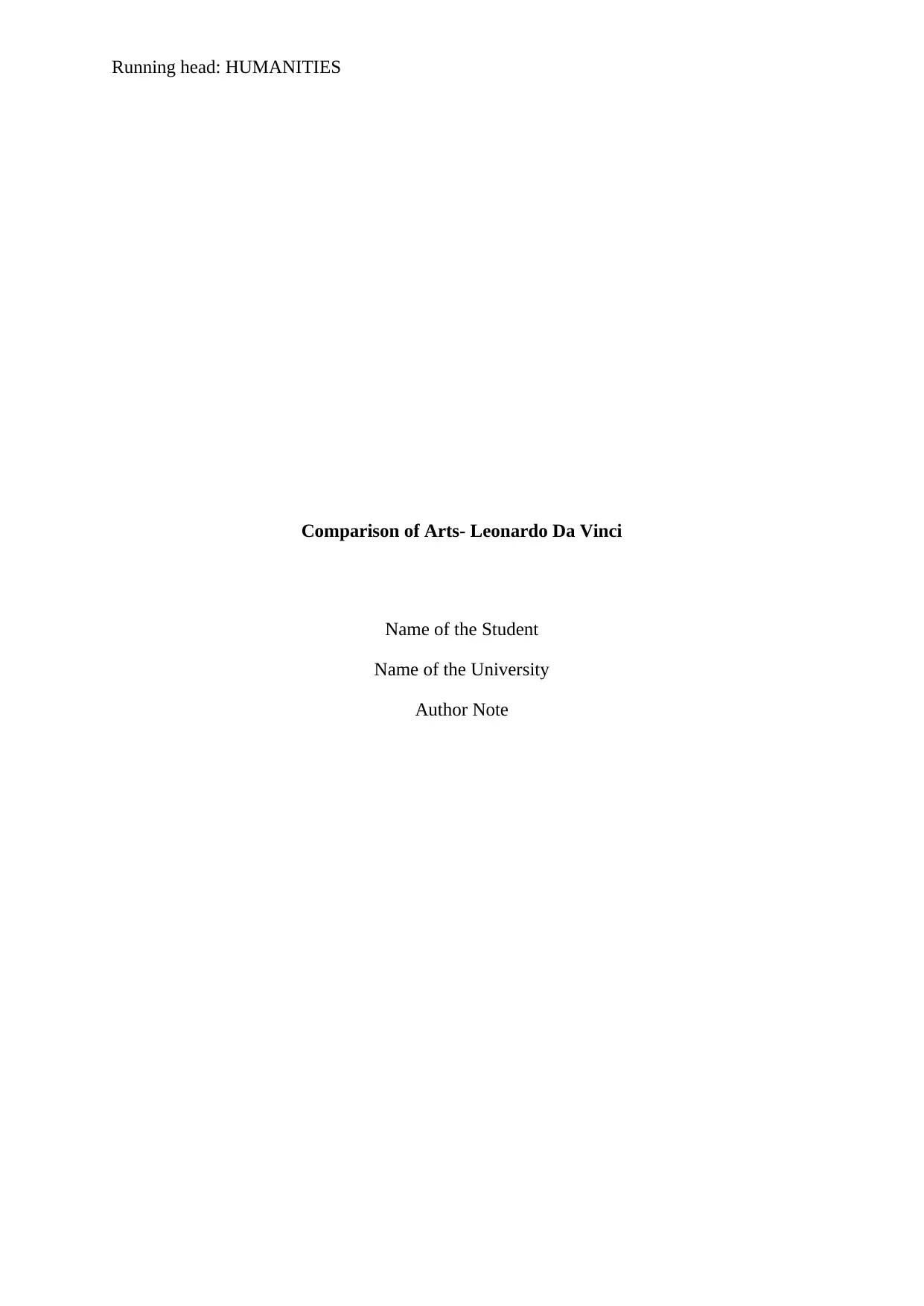
Running head: HUMANITIES
Comparison of Arts- Leonardo Da Vinci
Name of the Student
Name of the University
Author Note
Comparison of Arts- Leonardo Da Vinci
Name of the Student
Name of the University
Author Note
Paraphrase This Document
Need a fresh take? Get an instant paraphrase of this document with our AI Paraphraser
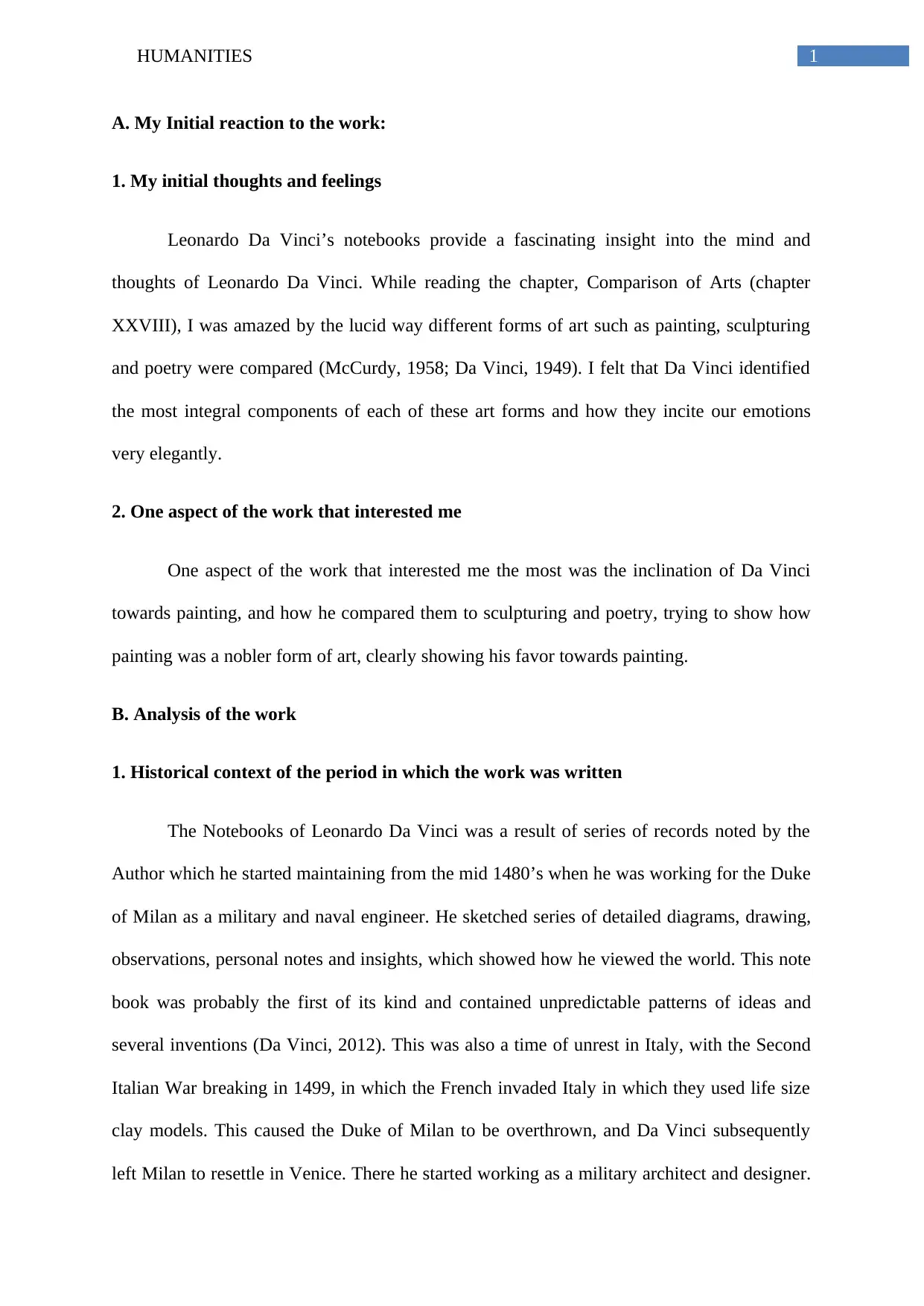
1HUMANITIES
A. My Initial reaction to the work:
1. My initial thoughts and feelings
Leonardo Da Vinci’s notebooks provide a fascinating insight into the mind and
thoughts of Leonardo Da Vinci. While reading the chapter, Comparison of Arts (chapter
XXVIII), I was amazed by the lucid way different forms of art such as painting, sculpturing
and poetry were compared (McCurdy, 1958; Da Vinci, 1949). I felt that Da Vinci identified
the most integral components of each of these art forms and how they incite our emotions
very elegantly.
2. One aspect of the work that interested me
One aspect of the work that interested me the most was the inclination of Da Vinci
towards painting, and how he compared them to sculpturing and poetry, trying to show how
painting was a nobler form of art, clearly showing his favor towards painting.
B. Analysis of the work
1. Historical context of the period in which the work was written
The Notebooks of Leonardo Da Vinci was a result of series of records noted by the
Author which he started maintaining from the mid 1480’s when he was working for the Duke
of Milan as a military and naval engineer. He sketched series of detailed diagrams, drawing,
observations, personal notes and insights, which showed how he viewed the world. This note
book was probably the first of its kind and contained unpredictable patterns of ideas and
several inventions (Da Vinci, 2012). This was also a time of unrest in Italy, with the Second
Italian War breaking in 1499, in which the French invaded Italy in which they used life size
clay models. This caused the Duke of Milan to be overthrown, and Da Vinci subsequently
left Milan to resettle in Venice. There he started working as a military architect and designer.
A. My Initial reaction to the work:
1. My initial thoughts and feelings
Leonardo Da Vinci’s notebooks provide a fascinating insight into the mind and
thoughts of Leonardo Da Vinci. While reading the chapter, Comparison of Arts (chapter
XXVIII), I was amazed by the lucid way different forms of art such as painting, sculpturing
and poetry were compared (McCurdy, 1958; Da Vinci, 1949). I felt that Da Vinci identified
the most integral components of each of these art forms and how they incite our emotions
very elegantly.
2. One aspect of the work that interested me
One aspect of the work that interested me the most was the inclination of Da Vinci
towards painting, and how he compared them to sculpturing and poetry, trying to show how
painting was a nobler form of art, clearly showing his favor towards painting.
B. Analysis of the work
1. Historical context of the period in which the work was written
The Notebooks of Leonardo Da Vinci was a result of series of records noted by the
Author which he started maintaining from the mid 1480’s when he was working for the Duke
of Milan as a military and naval engineer. He sketched series of detailed diagrams, drawing,
observations, personal notes and insights, which showed how he viewed the world. This note
book was probably the first of its kind and contained unpredictable patterns of ideas and
several inventions (Da Vinci, 2012). This was also a time of unrest in Italy, with the Second
Italian War breaking in 1499, in which the French invaded Italy in which they used life size
clay models. This caused the Duke of Milan to be overthrown, and Da Vinci subsequently
left Milan to resettle in Venice. There he started working as a military architect and designer.
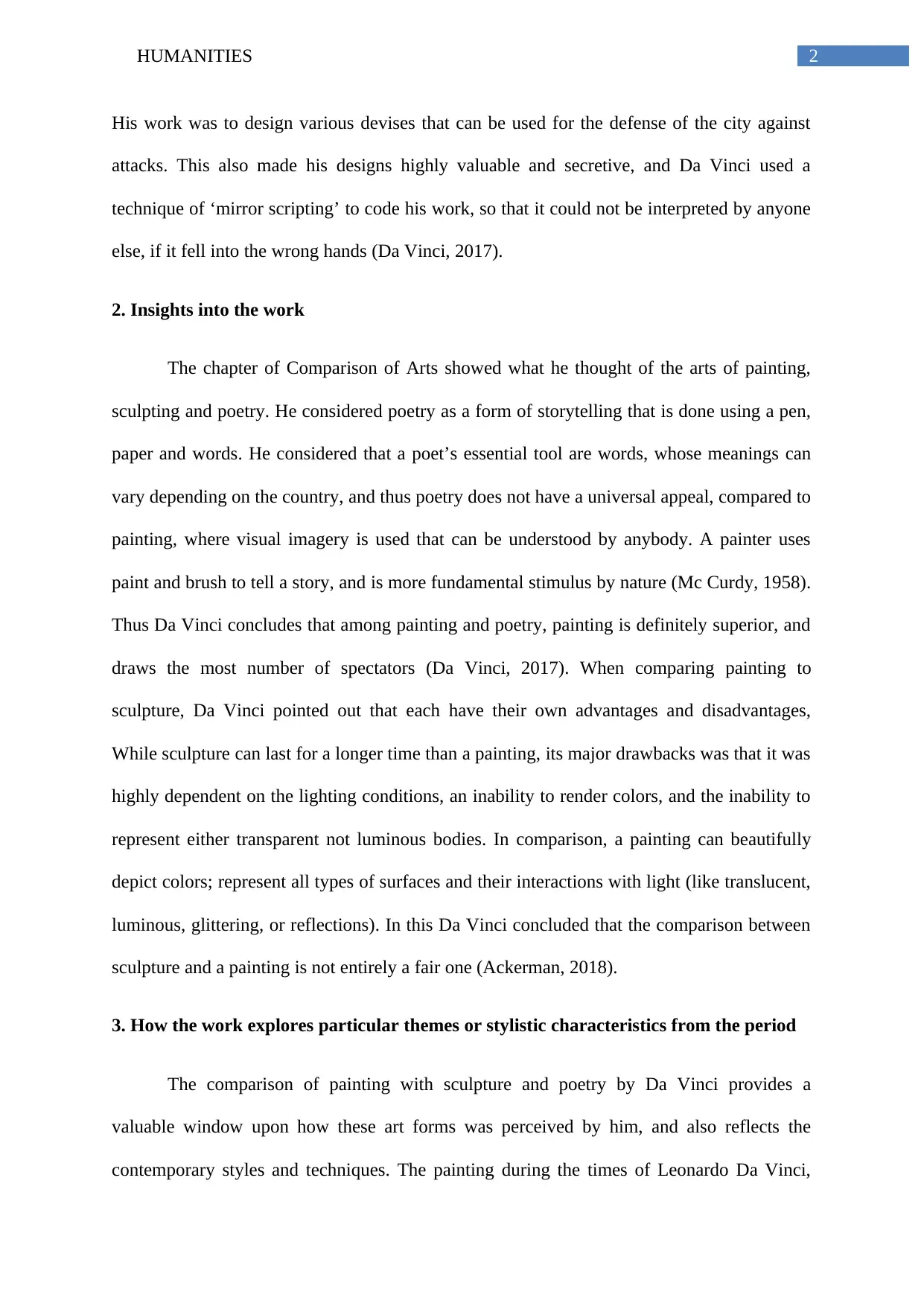
2HUMANITIES
His work was to design various devises that can be used for the defense of the city against
attacks. This also made his designs highly valuable and secretive, and Da Vinci used a
technique of ‘mirror scripting’ to code his work, so that it could not be interpreted by anyone
else, if it fell into the wrong hands (Da Vinci, 2017).
2. Insights into the work
The chapter of Comparison of Arts showed what he thought of the arts of painting,
sculpting and poetry. He considered poetry as a form of storytelling that is done using a pen,
paper and words. He considered that a poet’s essential tool are words, whose meanings can
vary depending on the country, and thus poetry does not have a universal appeal, compared to
painting, where visual imagery is used that can be understood by anybody. A painter uses
paint and brush to tell a story, and is more fundamental stimulus by nature (Mc Curdy, 1958).
Thus Da Vinci concludes that among painting and poetry, painting is definitely superior, and
draws the most number of spectators (Da Vinci, 2017). When comparing painting to
sculpture, Da Vinci pointed out that each have their own advantages and disadvantages,
While sculpture can last for a longer time than a painting, its major drawbacks was that it was
highly dependent on the lighting conditions, an inability to render colors, and the inability to
represent either transparent not luminous bodies. In comparison, a painting can beautifully
depict colors; represent all types of surfaces and their interactions with light (like translucent,
luminous, glittering, or reflections). In this Da Vinci concluded that the comparison between
sculpture and a painting is not entirely a fair one (Ackerman, 2018).
3. How the work explores particular themes or stylistic characteristics from the period
The comparison of painting with sculpture and poetry by Da Vinci provides a
valuable window upon how these art forms was perceived by him, and also reflects the
contemporary styles and techniques. The painting during the times of Leonardo Da Vinci,
His work was to design various devises that can be used for the defense of the city against
attacks. This also made his designs highly valuable and secretive, and Da Vinci used a
technique of ‘mirror scripting’ to code his work, so that it could not be interpreted by anyone
else, if it fell into the wrong hands (Da Vinci, 2017).
2. Insights into the work
The chapter of Comparison of Arts showed what he thought of the arts of painting,
sculpting and poetry. He considered poetry as a form of storytelling that is done using a pen,
paper and words. He considered that a poet’s essential tool are words, whose meanings can
vary depending on the country, and thus poetry does not have a universal appeal, compared to
painting, where visual imagery is used that can be understood by anybody. A painter uses
paint and brush to tell a story, and is more fundamental stimulus by nature (Mc Curdy, 1958).
Thus Da Vinci concludes that among painting and poetry, painting is definitely superior, and
draws the most number of spectators (Da Vinci, 2017). When comparing painting to
sculpture, Da Vinci pointed out that each have their own advantages and disadvantages,
While sculpture can last for a longer time than a painting, its major drawbacks was that it was
highly dependent on the lighting conditions, an inability to render colors, and the inability to
represent either transparent not luminous bodies. In comparison, a painting can beautifully
depict colors; represent all types of surfaces and their interactions with light (like translucent,
luminous, glittering, or reflections). In this Da Vinci concluded that the comparison between
sculpture and a painting is not entirely a fair one (Ackerman, 2018).
3. How the work explores particular themes or stylistic characteristics from the period
The comparison of painting with sculpture and poetry by Da Vinci provides a
valuable window upon how these art forms was perceived by him, and also reflects the
contemporary styles and techniques. The painting during the times of Leonardo Da Vinci,
⊘ This is a preview!⊘
Do you want full access?
Subscribe today to unlock all pages.

Trusted by 1+ million students worldwide
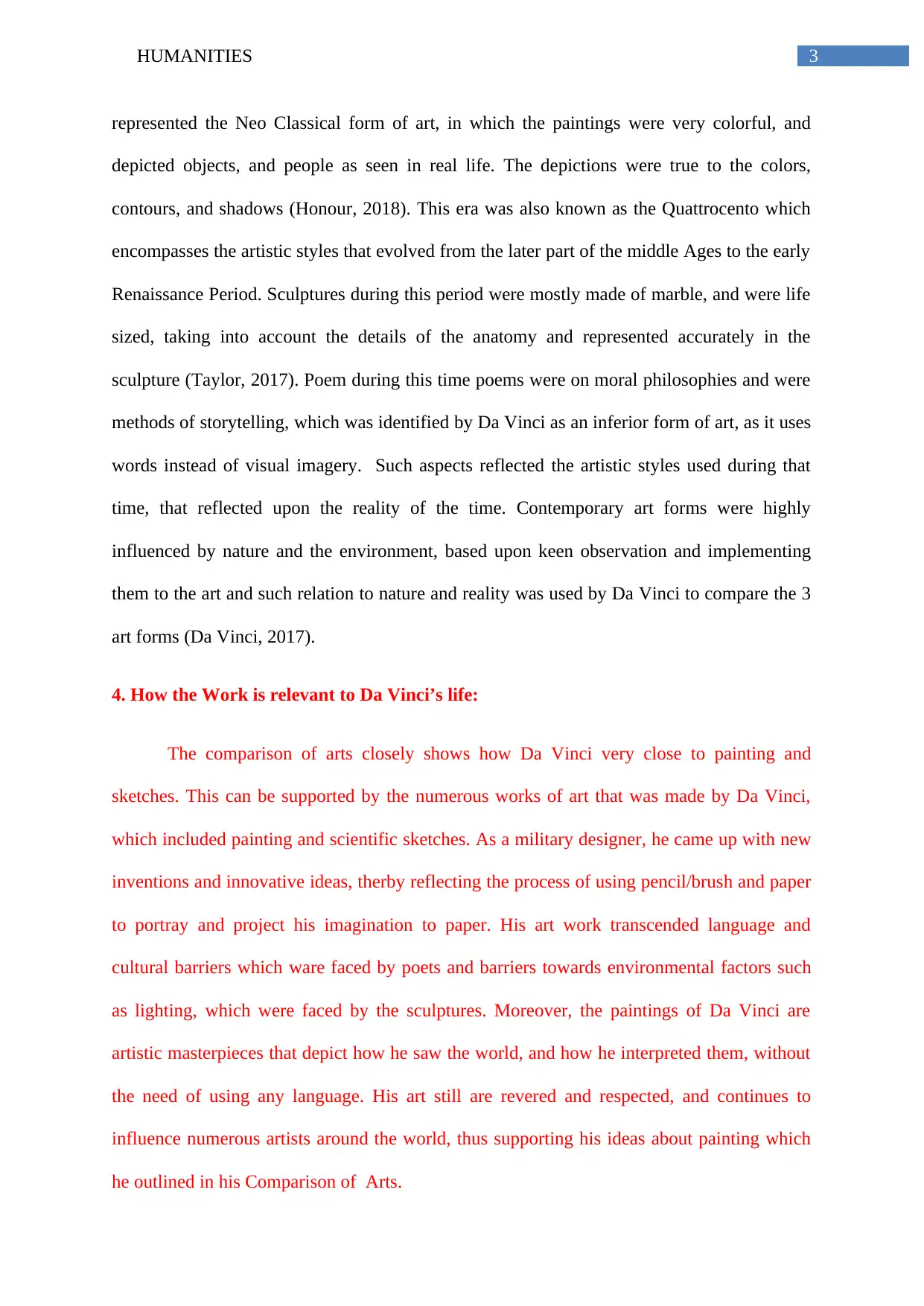
3HUMANITIES
represented the Neo Classical form of art, in which the paintings were very colorful, and
depicted objects, and people as seen in real life. The depictions were true to the colors,
contours, and shadows (Honour, 2018). This era was also known as the Quattrocento which
encompasses the artistic styles that evolved from the later part of the middle Ages to the early
Renaissance Period. Sculptures during this period were mostly made of marble, and were life
sized, taking into account the details of the anatomy and represented accurately in the
sculpture (Taylor, 2017). Poem during this time poems were on moral philosophies and were
methods of storytelling, which was identified by Da Vinci as an inferior form of art, as it uses
words instead of visual imagery. Such aspects reflected the artistic styles used during that
time, that reflected upon the reality of the time. Contemporary art forms were highly
influenced by nature and the environment, based upon keen observation and implementing
them to the art and such relation to nature and reality was used by Da Vinci to compare the 3
art forms (Da Vinci, 2017).
4. How the Work is relevant to Da Vinci’s life:
The comparison of arts closely shows how Da Vinci very close to painting and
sketches. This can be supported by the numerous works of art that was made by Da Vinci,
which included painting and scientific sketches. As a military designer, he came up with new
inventions and innovative ideas, therby reflecting the process of using pencil/brush and paper
to portray and project his imagination to paper. His art work transcended language and
cultural barriers which ware faced by poets and barriers towards environmental factors such
as lighting, which were faced by the sculptures. Moreover, the paintings of Da Vinci are
artistic masterpieces that depict how he saw the world, and how he interpreted them, without
the need of using any language. His art still are revered and respected, and continues to
influence numerous artists around the world, thus supporting his ideas about painting which
he outlined in his Comparison of Arts.
represented the Neo Classical form of art, in which the paintings were very colorful, and
depicted objects, and people as seen in real life. The depictions were true to the colors,
contours, and shadows (Honour, 2018). This era was also known as the Quattrocento which
encompasses the artistic styles that evolved from the later part of the middle Ages to the early
Renaissance Period. Sculptures during this period were mostly made of marble, and were life
sized, taking into account the details of the anatomy and represented accurately in the
sculpture (Taylor, 2017). Poem during this time poems were on moral philosophies and were
methods of storytelling, which was identified by Da Vinci as an inferior form of art, as it uses
words instead of visual imagery. Such aspects reflected the artistic styles used during that
time, that reflected upon the reality of the time. Contemporary art forms were highly
influenced by nature and the environment, based upon keen observation and implementing
them to the art and such relation to nature and reality was used by Da Vinci to compare the 3
art forms (Da Vinci, 2017).
4. How the Work is relevant to Da Vinci’s life:
The comparison of arts closely shows how Da Vinci very close to painting and
sketches. This can be supported by the numerous works of art that was made by Da Vinci,
which included painting and scientific sketches. As a military designer, he came up with new
inventions and innovative ideas, therby reflecting the process of using pencil/brush and paper
to portray and project his imagination to paper. His art work transcended language and
cultural barriers which ware faced by poets and barriers towards environmental factors such
as lighting, which were faced by the sculptures. Moreover, the paintings of Da Vinci are
artistic masterpieces that depict how he saw the world, and how he interpreted them, without
the need of using any language. His art still are revered and respected, and continues to
influence numerous artists around the world, thus supporting his ideas about painting which
he outlined in his Comparison of Arts.
Paraphrase This Document
Need a fresh take? Get an instant paraphrase of this document with our AI Paraphraser
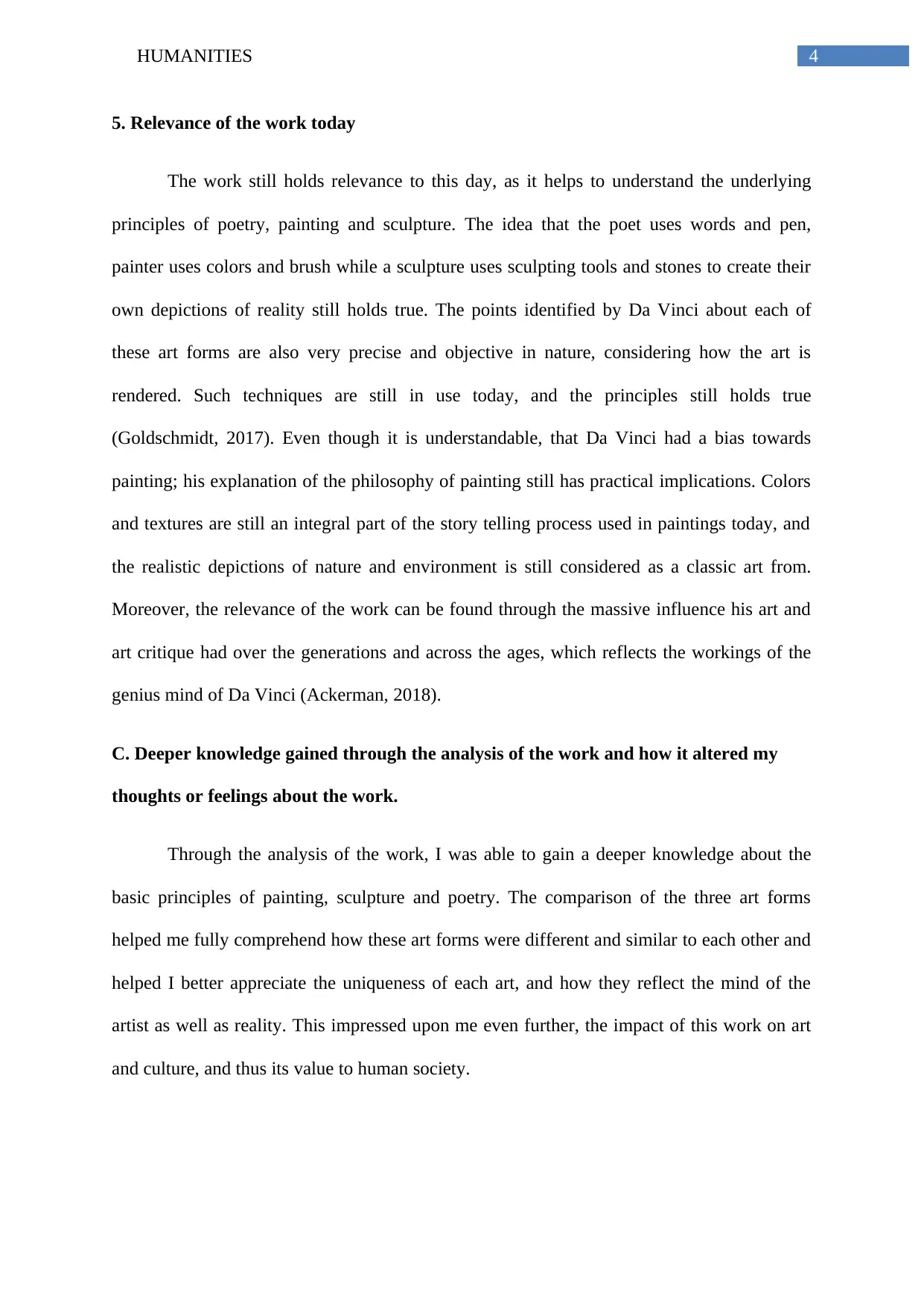
4HUMANITIES
5. Relevance of the work today
The work still holds relevance to this day, as it helps to understand the underlying
principles of poetry, painting and sculpture. The idea that the poet uses words and pen,
painter uses colors and brush while a sculpture uses sculpting tools and stones to create their
own depictions of reality still holds true. The points identified by Da Vinci about each of
these art forms are also very precise and objective in nature, considering how the art is
rendered. Such techniques are still in use today, and the principles still holds true
(Goldschmidt, 2017). Even though it is understandable, that Da Vinci had a bias towards
painting; his explanation of the philosophy of painting still has practical implications. Colors
and textures are still an integral part of the story telling process used in paintings today, and
the realistic depictions of nature and environment is still considered as a classic art from.
Moreover, the relevance of the work can be found through the massive influence his art and
art critique had over the generations and across the ages, which reflects the workings of the
genius mind of Da Vinci (Ackerman, 2018).
C. Deeper knowledge gained through the analysis of the work and how it altered my
thoughts or feelings about the work.
Through the analysis of the work, I was able to gain a deeper knowledge about the
basic principles of painting, sculpture and poetry. The comparison of the three art forms
helped me fully comprehend how these art forms were different and similar to each other and
helped I better appreciate the uniqueness of each art, and how they reflect the mind of the
artist as well as reality. This impressed upon me even further, the impact of this work on art
and culture, and thus its value to human society.
5. Relevance of the work today
The work still holds relevance to this day, as it helps to understand the underlying
principles of poetry, painting and sculpture. The idea that the poet uses words and pen,
painter uses colors and brush while a sculpture uses sculpting tools and stones to create their
own depictions of reality still holds true. The points identified by Da Vinci about each of
these art forms are also very precise and objective in nature, considering how the art is
rendered. Such techniques are still in use today, and the principles still holds true
(Goldschmidt, 2017). Even though it is understandable, that Da Vinci had a bias towards
painting; his explanation of the philosophy of painting still has practical implications. Colors
and textures are still an integral part of the story telling process used in paintings today, and
the realistic depictions of nature and environment is still considered as a classic art from.
Moreover, the relevance of the work can be found through the massive influence his art and
art critique had over the generations and across the ages, which reflects the workings of the
genius mind of Da Vinci (Ackerman, 2018).
C. Deeper knowledge gained through the analysis of the work and how it altered my
thoughts or feelings about the work.
Through the analysis of the work, I was able to gain a deeper knowledge about the
basic principles of painting, sculpture and poetry. The comparison of the three art forms
helped me fully comprehend how these art forms were different and similar to each other and
helped I better appreciate the uniqueness of each art, and how they reflect the mind of the
artist as well as reality. This impressed upon me even further, the impact of this work on art
and culture, and thus its value to human society.
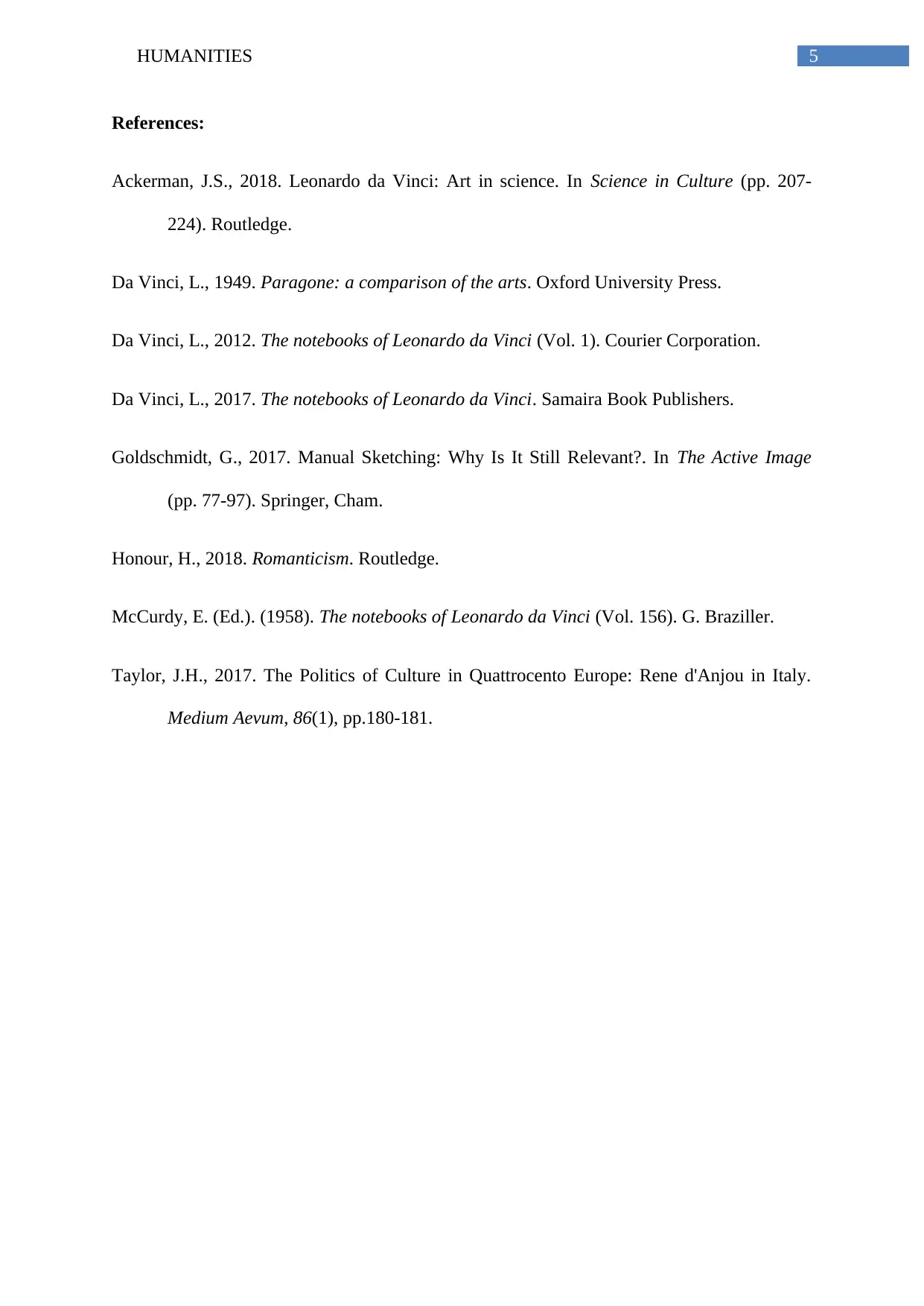
5HUMANITIES
References:
Ackerman, J.S., 2018. Leonardo da Vinci: Art in science. In Science in Culture (pp. 207-
224). Routledge.
Da Vinci, L., 1949. Paragone: a comparison of the arts. Oxford University Press.
Da Vinci, L., 2012. The notebooks of Leonardo da Vinci (Vol. 1). Courier Corporation.
Da Vinci, L., 2017. The notebooks of Leonardo da Vinci. Samaira Book Publishers.
Goldschmidt, G., 2017. Manual Sketching: Why Is It Still Relevant?. In The Active Image
(pp. 77-97). Springer, Cham.
Honour, H., 2018. Romanticism. Routledge.
McCurdy, E. (Ed.). (1958). The notebooks of Leonardo da Vinci (Vol. 156). G. Braziller.
Taylor, J.H., 2017. The Politics of Culture in Quattrocento Europe: Rene d'Anjou in Italy.
Medium Aevum, 86(1), pp.180-181.
References:
Ackerman, J.S., 2018. Leonardo da Vinci: Art in science. In Science in Culture (pp. 207-
224). Routledge.
Da Vinci, L., 1949. Paragone: a comparison of the arts. Oxford University Press.
Da Vinci, L., 2012. The notebooks of Leonardo da Vinci (Vol. 1). Courier Corporation.
Da Vinci, L., 2017. The notebooks of Leonardo da Vinci. Samaira Book Publishers.
Goldschmidt, G., 2017. Manual Sketching: Why Is It Still Relevant?. In The Active Image
(pp. 77-97). Springer, Cham.
Honour, H., 2018. Romanticism. Routledge.
McCurdy, E. (Ed.). (1958). The notebooks of Leonardo da Vinci (Vol. 156). G. Braziller.
Taylor, J.H., 2017. The Politics of Culture in Quattrocento Europe: Rene d'Anjou in Italy.
Medium Aevum, 86(1), pp.180-181.
⊘ This is a preview!⊘
Do you want full access?
Subscribe today to unlock all pages.

Trusted by 1+ million students worldwide
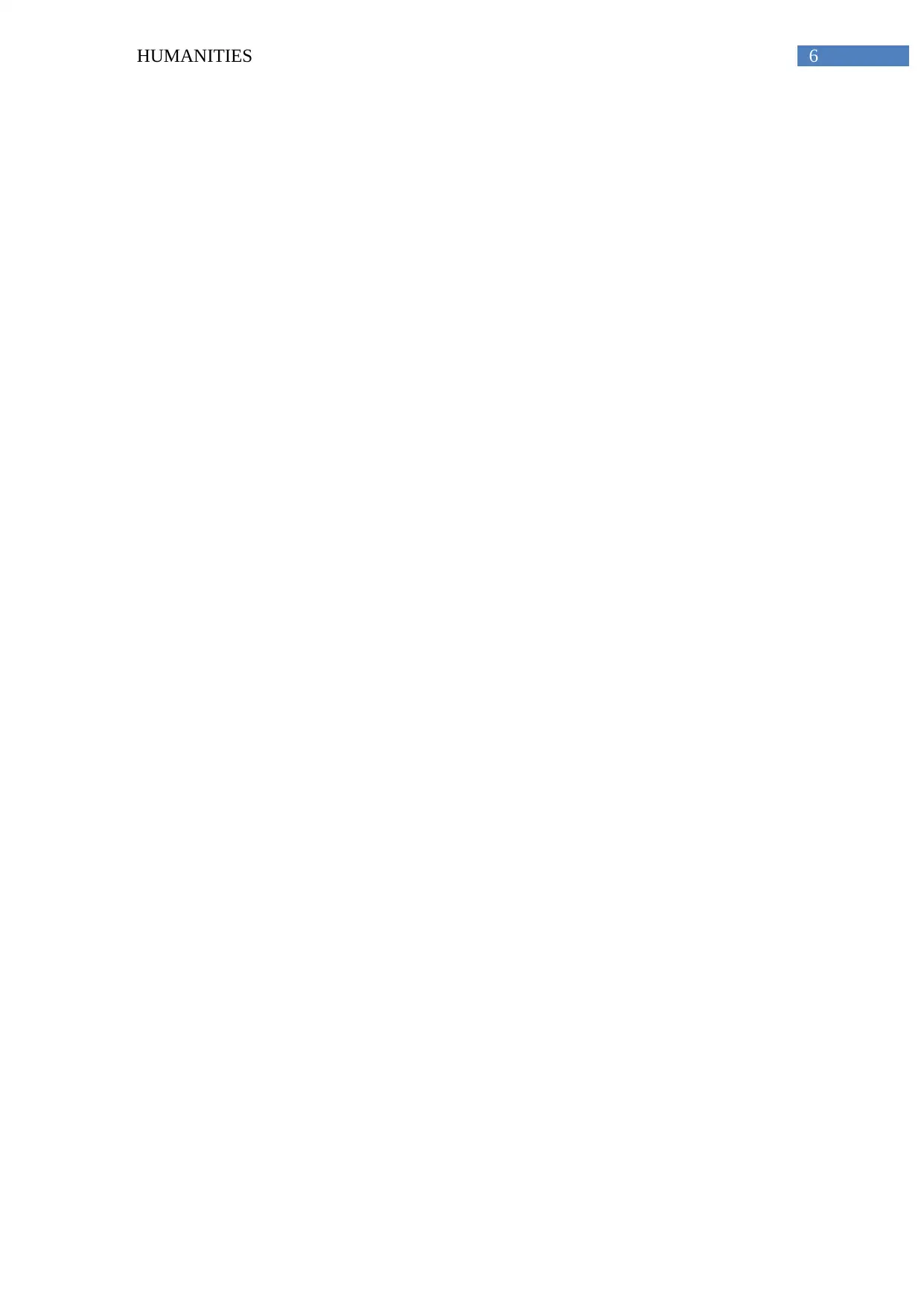
6HUMANITIES
1 out of 7
Your All-in-One AI-Powered Toolkit for Academic Success.
+13062052269
info@desklib.com
Available 24*7 on WhatsApp / Email
![[object Object]](/_next/static/media/star-bottom.7253800d.svg)
Unlock your academic potential
Copyright © 2020–2025 A2Z Services. All Rights Reserved. Developed and managed by ZUCOL.
